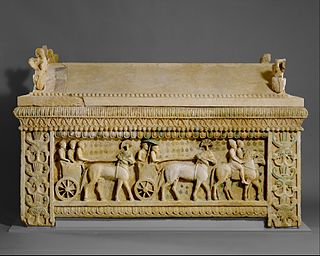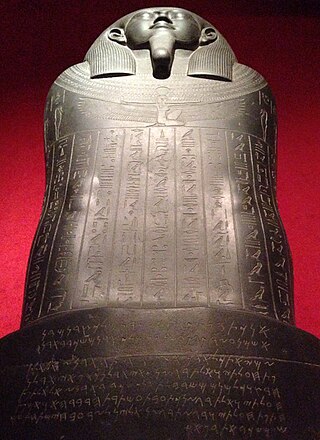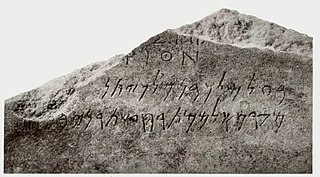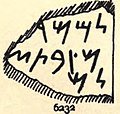
Amathus or Amathous was an ancient city and one of the ancient royal cities of Cyprus until about 300 BC. Some of its remains can be seen today on the southern coast in front of Agios Tychonas, about 24 miles (39 km) west of Larnaca and 6 miles (9.7 km) east of Limassol. Its ancient cult sanctuary of Aphrodite was the second most important in Cyprus, her homeland, after Paphos.

The sarcophagus ofEshmunazar II is a 6th-century BC sarcophagus unearthed in 1855 in the grounds of an ancient necropolis southeast of the city of Sidon, in modern-day Lebanon, that contained the body of Eshmunazar II, Phoenician King of Sidon. One of only three Ancient Egyptian sarcophagi found outside Egypt, with the other two belonging to Eshmunazar's parents King Tabnit and Queen Amoashtart, it was likely carved in Egypt from local amphibolite, and captured as booty by the Sidonians during their participation in Cambyses II's conquest of Egypt in 525 BC. The sarcophagus has two sets of Phoenician inscriptions, one on its lid and a partial copy of it on the sarcophagus trough, around the curvature of the head. The lid inscription was of great significance upon its discovery as it was the first Phoenician language inscription to be discovered in Phoenicia proper, the most detailed Phoenician text ever found anywhere up to that point, and is today the second longest extant Phoenician inscription, after the Karatepe bilingual.

Idalion or Idalium was an ancient city in Cyprus, in modern Dali, Nicosia District. The city was founded on the copper trade in the 3rd millennium BC. Its name in the 8th century BC was "Ed-di-al" as it appears on the Sargon Stele of 707 BC, and a little later on the Prism of Esarhaddon.
Sir John Linton Myres OBE FBA FRAI was a British archaeologist and academic, who conducted excavations in Cyprus during the late 19th and early 20th centuries.

The Ahiram sarcophagus was the sarcophagus of a Phoenician King of Byblos, discovered in 1923 by the French excavator Pierre Montet in tomb V of the royal necropolis of Byblos.

Kition was a Phoenician and Ancient Greek city-kingdom on the southern coast of Cyprus, one of the Ten city-kingdoms of Cyprus. According to the text on the plaque closest to the excavation pit of the Kathari site, it was established in the 13th century BC by Greek (Achaean) settlers, after the Trojan war.
Kanaanäische und Aramäische Inschriften, or KAI, is the standard source for the original text of Canaanite and Aramaic inscriptions not contained in the Hebrew Bible.

The Tabnit sarcophagus is the sarcophagus of the Phoenician King of Sidon Tabnit, the father of King Eshmunazar II. It is decorated with two separate and unrelated inscriptions – one in Egyptian hieroglyphs and one in the Phoenician alphabet. The latter contains a curse for those who open the tomb, promising impotency and loss of an afterlife.
Vassos Karageorghis FBA was a Cypriot archaeologist and director of the Department of Antiquities, Cyprus.

The Canaanite and Aramaic inscriptions, also known as Northwest Semitic inscriptions, are the primary extra-Biblical source for understanding of the society and history of the ancient Phoenicians, Hebrews and Arameans. Semitic inscriptions may occur on stone slabs, pottery ostraca, ornaments, and range from simple names to full texts. The older inscriptions form a Canaanite–Aramaic dialect continuum, exemplified by writings which scholars have struggled to fit into either category, such as the Stele of Zakkur and the Deir Alla Inscription.

The Kition Tariffs are two important Phoenician inscriptions found in Kition (Larnaka), Cyprus in 1879. The longer of the two has been described as "Among the longest and most important Phoenician inscriptions from Cyprus".

The Idalion bilingual is a bilingual Cypriot–Phoenician inscription found in 1869 in Dali, Cyprus. It was the key to the decipherment of the Cypriot syllabary, in the manner of the Rosetta Stone to hieroglyphs. The discovery of the inscription was first announced by Paul Schröder in May 1872. It is dated to 388 BCE. The Phoenician inscription is known as KAI 38 and CIS I 89.

The Tamassos bilinguals are a pair of bilingual Cypriot–Phoenician inscriptions on stone pedestals found in 1885 in Tamassos, Cyprus. It has been dated to 363 BC.

Phoenician metal bowls are approximately 90 decorative bowls made in the 7th–8th centuries BCE from bronze, silver and gold, found since the mid-19th century in the Eastern Mediterranean and Iraq. They were historically attributed to the Phoenicians, but are today considered to have been made by a broader group of Levantine peoples.

The Larnakas tis Lapithou pedestal inscription, also known as KAI 43 or RES 1211, is a sixteen-line Phoenician inscription on the pedestal of a now lost statue of a local Cypriote governor, Yatonbaal. It is on a piece of greyish marble, measuring 44 by 69 centimeters, found in 1893 by Émile Deschamps at the foot of a hill near the northeastern Cypriote village of Larnax-Lapithou, in a field strewn with ancient stones, "that local inhabitants use as building material".

The Rhodes Phoenician-Greek bilingual inscriptions are three short bilingual inscriptions found between 1914 and 1968 in Rhodes.

The Carthage Tariff is a Punic language inscription from the third century BCE, found on a fragments of a limestone stela in 1856-58 at Carthage in Tunisia. It is thought to be related to the Marseille Tariff, found two decades earlier.
The Pierides Kition inscriptions are seven Phoenician inscriptions found in Kition by Demetrios Pierides in 1881 and acquired by the Louvre in 1885.

The Carthage Festival inscription or Carthage Festival Offering inscription is an inscription from Carthage in the Punic language that probably describes the liturgy of a festival of, at least, five days. It is dated to the fourth or third century BCE.
The Eshmun obelisk is an obelisk with a two-line Phoenician inscription found in Kition, Cyprus by Claude Delaval Cobham in 1881. It is known as CIS I 44, KI 21, NE 420,2 and NSI 15. It was used as a Baetylus, or devotional object.


















